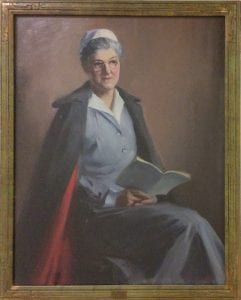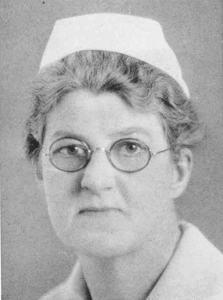By: Samantha Riley, Bicentennial Intern, Class of 2020, French and Anthropology, IUPUI
Edited by: Bre Anne Briskey, Bicentennial Graduate Assistant

“It is very flat out here and it does look terrible, but I think there is an opportunity to do a great deal and we are going to be very happy.”–Ethel Palmer Clarke[1]
As one of the early directors of the IU School of Nursing, Ethel Palmer Clarke guided the school during its pivotal years. As director, Clarke firmly established and reinforced nursing standards and oversaw the program’s expansion. Due to Clarke’s dedication, the nursing school flourished and is now one of the top nursing schools in the nation.
Early Life and Education
Ethel Palmer Clarke was born around 1878 in Lynton, Devon County, England.[2] As a teenager, her family immigrated to the United States.[3] Clarke studied nursing at the University of Maryland Training School for Nurses, where she graduated in 1906.[4]
After graduation, she received a job offer and became the superintendent of DeSoto Sanitarium in Jacksonville, FL. In 1911, Clarke returned to her alma mater to become the superintendent of nurses at University Hospital. While working as the superintendent of nurses, Clarke attended the Teacher’s College at Columbia University to further her education.[5]
Even after Clarke married her husband, Thomas Clarke, she continued to work as a nurse at a time when most women stopped working after they married.[6]
Career
Clarke came to Indiana University in 1915 as the director of the Indiana University Training School for Nurses, later renamed as the Indiana University School of Nursing.[7] As the director of the school, she was responsible for student education and hospital nursing services.[8] Clarke took it upon herself to design a nursing pin for the Training School for Nurses, as well as to modify the nurses’ uniforms to include a cape, which was gray lined with scarlet flannel and had a red IU monogram on the collar.[9]
Under Clarke’s guidance, the school grew. She planned and organized entrance exams for potential nursing students.[10] Clarke also ensured that the potential nursing students were qualified by requiring them to provide letters of reference, a high school transcript, a doctor’s certificate that the applicant was in good health, and a personal interview. To be admitted to the school, the applicants had to have three college level units of English, two units of mathematics, two units in a foreign language, one unit of history, one unit of science, and two additional units.[11]
The program grew from 12 students to 168. On June 13, 1917, two years after Clarke became the director, the school’s first commencement was held with five students receiving the Graduate Nurse Diploma from Indiana University. [12]

Students knew Mrs. Clarke as “very stately, dignified, and reserved and commanded the respect of everyone. She was also extremely critical and strict. At the same time, she was most understanding and fair.”[13]
She was passionate about creating dedicated and honorable nurses. When six nursing students approached Clarke with the interest in creating a nursing sorority to encourage scholarship and high achievement in 1922, Clarke believed this to be a wonderful idea.
She provided her full support for the creation of the nursing sorority, on account of it being a society based on academic scholarship. This resulted in the creation of Sigma Theta Tau. Because of her support and work with the chapter founders, she became known as the mother of the chapter.[14]
Nursing students in the Training School were required to live on site, but finding housing proved to be difficult. Nurses lived in a variety of situations, from Long Hospital to nearby cottages. There needed to be a larger, more unified location for the nursing students.
Consequently, in 1917, the school began to build the Ball Nurses’ Residence, known today as Ball Hall.[15] As the director of the nursing program, Mrs. Clarke oversaw the design of the Ball Nurses’ Residence. She selected the furnishings and equipment for the new residence hall herself. [16] Formally dedicated on October 7, 1928, the Ball Nurses’ Residence had 165 rooms for students, and housed classrooms, laboratories, offices, a demonstration room, a gymnasium, and a library.[17]
Contributions
Alongside aiding in the creation of the Ball Nurses’ Residence, Clarke helped to establish the nursing school as an autonomous school. When the school was first established, information about the school was listed in the IU Medical School Bulletin.
In 1917, Clarke oversaw the creation of the school’s own bulletin, which provided information to people interested in nursing. In the following year, in 1918, Clarke helped to establish the Alumnae Association.[18]

During Clarke’s tenure, she also oversaw changes in the curriculum. Courses in nursing, sociology, social work, and social psychiatry were added and the number of courses students needed to take in dietetics, English composition, and English literature were increased while chemistry and public speaking courses were removed from the curriculum.[19]
Legacy
Clarke served as the director of the nursing program until 1931. During her tenue, the school grew exponentially: the number of hospitals grew from one to four, with hospital beds from 105 to 420, the number of student and graduate nurses grew, and the curriculum was revised, with students having more opportunities to engage in activities. [20]
After Clarke’s resignation, she and her husband moved to Bridgeport, CT, where she continued her work as the director of nurses at Bridgeport Hospital.[21] She continued in this role until 1941, when she retired. [22] Clarke passed away in 1970 in Clinton, CT.[23] Clarke’s long-lasting legacy is still visible today, as demonstrated by the strong presence of the IU School of Nursing in both IU and the larger community.
Bibliography
- “Ethel P. Clarke,” IU Newsroom, URL: https://news.iu.edu/stories/features/historical-women/index.html.
- Marriner-Tomey, Ann, ed. Nursing at Indiana University: 75 Years at the Heart of Health Care. Indiana University School of Nursing, 1989.
- “Mrs. Ethel P. Clarke Obituary,” Hartford Courant, 02 June 1970, pg. 4.
- MSS 51, IUPUI University Library Special Collections and Archives.
- Notice of Death: Ethel P. Clarke, UA 025, Box 14, IUPUI Faculty Council Records, IUPUI University Library Special Collections and Archives.
- “Site 3: Ball Nurses’ Residence,” Women Building IUPUI: A Walking Trail. http://www.iupui.edu/~history/OLDSITE/trail/3.htm.
- “Our History,” School of Nursing. https://nursing.iupui.edu/about/history/index.shtml.
- Owen, Mary. “Ethel P. Clarke,” Medical Trail Booklet.
Notes
[1] “Ethel P. Clarke,” IU Newsroom, URL: https://news.iu.edu/stories/features/historical-women/index.html.
[2] “Mrs. Ethel P. Clarke Obituary,” Hartford Courant, 02 June 1970, pg. 4, URL: https://www.newspapers.com/image/371276429/?terms=%22Ethel%20Palmer%20Clarke%22&match=1; Notice of Death: Ethel P. Clarke, UA 025, Box 14, IUPUI Faculty Council Records, IUPUI University Library Special Collections and Archives.
[3] Ann Marriner-Tomey, Nursing at Indiana University: 75 Years at the Heart of Health Care. Indiana University School of Nursing, 1989, pg. 6.
[4] Notice of Death: Ethel P. Clarke, UA 025, Box 14, IUPUI Faculty Council Records, IUPUI University Library Special Collections and Archives.
[5] Notice of Death: Ethel P. Clarke, UA 025, Box 14, IUPUI Faculty Council Records, IUPUI University Library Special Collections and Archives.
[6] Mary Owen, “Ethel P. Clarke,” Medical Trail Booklet.
[7] Notice of Death: Ethel P. Clarke, UA 025, Box 14, IUPUI Faculty Council Records, IUPUI University Library Special Collections and Archives.
[8] “Our History,” School of Nursing. https://nursing.iupui.edu/about/history/index.shtml.
[9] Mary Owen, “Ethel P. Clarke,” Medical Trail Booklet; “Ethel P. Clarke,” IU Newsroom, URL: https://news.iu.edu/stories/features/historical-women/index.html.
[10] Mary Owen, “Ethel P. Clarke,” Medical Trail Booklet.
[11] Ann Marriner-Tomey, Nursing at Indiana University: 75 Years at the Heart of Health Care. Indiana University School of Nursing, 1989, pg. 6.
[12] Mary Owen, “Ethel P. Clarke,” Medical Trail Booklet.
[13] Mary Owen, “Ethel P. Clarke,” Medical Trail Booklet.
[14] MSS 51, IUPUI University Library Special Collections and Archives.
[15] “Site 3: Ball Nurses’ Residence,” Women Building IUPUI: A Walking Trail. http://www.iupui.edu/~history/OLDSITE/trail/3.htm.
[16] Mary Owen, “Ethel P. Clarke,” Medical Trail Booklet.
[17] Ann Marriner-Tomey, Nursing at Indiana University: 75 Years at the Heart of Health Care. Indiana University School of Nursing, 1989, pg. 10.
[18] Ann Marriner-Tomey, Nursing at Indiana University: 75 Years at the Heart of Health Care. Indiana University School of Nursing, 1989, pg. 6-7.
[19] Ann Marriner-Tomey, Nursing at Indiana University: 75 Years at the Heart of Health Care. Indiana University School of Nursing, 1989, pg. 7.
[20] Ann Marriner-Tomey, Nursing at Indiana University: 75 Years at the Heart of Health Care. Indiana University School of Nursing, 1989, pg. 10-11.
[21] Mary Owen, “Ethel P. Clarke,” Medical Trail Booklet.
[22] Ann Marriner-Tomey, Nursing at Indiana University: 75 Years at the Heart of Health Care. Indiana University School of Nursing, 1989, pg. 11.
[23] “Mrs. Ethel P. Clarke Obituary,” Hartford Courant, 02 June 1970, pg. 4, URL: https://www.newspapers.com/image/371276429/?terms=%22Ethel%20Palmer%20Clarke%22&match=1.